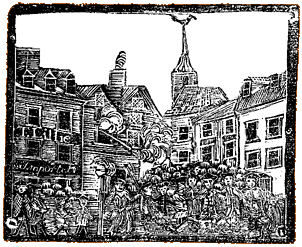Boston's First Revolutionary Death, 237 Years Ago
 For a couple of days I’ve been discussing how in early 1770 Boston was aboil with conflict over a “nonimportation” of goods from Britain to protest the Townshend duties. Most of the town supported this boycott, and Whigs were pressuring the handful of merchants and shopkeepers who refused to sign on.
For a couple of days I’ve been discussing how in early 1770 Boston was aboil with conflict over a “nonimportation” of goods from Britain to protest the Townshend duties. Most of the town supported this boycott, and Whigs were pressuring the handful of merchants and shopkeepers who refused to sign on.
Part of that pressure in early February were crowds of boys marching outside importers’ stores; these protests appeared every Thursday morning when there was no school. On 22 Feb 1770, these young Whigs focused their attention on small merchant Theophilus Lillie. They set up their “Pageantry” on Union Street: a hand pointing to his shop with the word IMPORTER, and an effigy of Lillie’s head on a pole.
Along came Ebenezer Richardson, a Customs service employee. As I described in a New England Ancestors article available online, Richardson had become notorious in his home town of Woburn for having impregnated his wife’s sister and letting blame fall on the town’s minister for several months. He then moved to Boston and made his living as a confidential informer, first for the Attorney General and then for the Customs service. When that work was exposed in the early 1760s, Richardson became even more unpopular, and started to work openly for Customs since no one else would employ him.
The Customs establishment opposed the nonimportation movement, and Richardson apparently took it upon himself to break up the boys’ protest of Lillie’s shop. First he tried to persuade two farmers in Boston for market day to knock down the carved head with their wagons. The drivers refused. Whig gentlemen watching the action laughed at Richardson’s efforts. He stomped off to his nearby home, shouting, “Perjury! Perjury!”
It’s unclear what Richardson was referring to, but, as the Boston Evening-Post reported, “The Boys on hearing the words began to gather round, and call him an informer.” Richardson and his wife Kezia (the same woman he had impregnated and eventually married years before) shooed them away. The boys said, “they would not, Kings high Way”—meaning they had every right to be on the street.
Richardson flourished a stick. The boys ran around “with the squeeling and noise they usually make on such occasion,” said the newspaper. The young mob, now numbering at least “60 or 70 Boys,” left Lillie’s shop and started pelting Richardson’s house with “Limon Peels,” witnesses later testified. The boys hit Kezia Richardson with an egg. Someone inside the house tossed out a brickbat, striking a sailor. He threw it back through a window.
A low-level Customs employee named George Wilmot came to the house and offered help. According to one of the Richardsons’ daughters, “Wilmot asked [my father] if he had any Gun.” Both men armed themselves with muskets.
Richardson came out his front door and yelled at the boys, “as sure as there was a G[od] in heaven, he’d blow a Lane thro ’em.” He “snapped” his gun—firing it with powder but no ball, like a blank shot. The boys scattered and came back again, no longer tossing “light rubbish of one kind or another” but throwing stones through windows.
Richardson reappeared with his musket at an upper window. The boys continued to throw rocks. Richardson fired his musket again. This time he had loaded it with buckshot pellets, “about the bigness of large peas.”
Some of those pellets sliced through the baggy pants of a sailor named Robert Patterson. A few pierced the right hand and thigh of a nineteen-year-old painter named Sammy Gore. Eleven pieces flew into the chest of Christopher Seider, a servant boy just about eleven years old, who was “stooping to take up a Stone.”
The wounded boys were taken into a nearby house. As the violence continued outside, Dr. Joseph Warren, Dr. Thomas Young, and other surgeons examined them. Christopher’s chest was gradually filling with blood. People brought his parents, poor German immigrants, from their little home at the far end of Boston Common. Clergymen came to pray with the family. Christopher Seider died around nine o’clock on the night of 22 February, the first death of Boston’s Revolutionary conflict.

1 comment:
A great post. Thanks.
Post a Comment